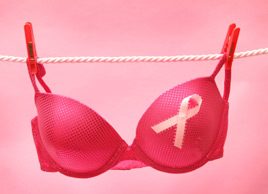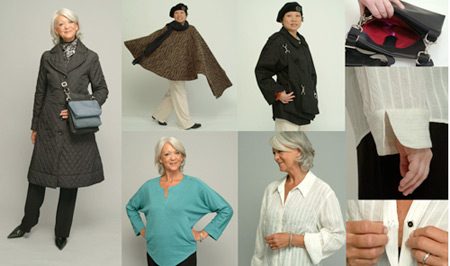Bras after breast cancer
For many survivors of breast cancer, wearing the right bra and prostheses can go a long way in helping them heal emotionally and physically. But finding bras after breast cancer isn’t always an easy task

Source: Web exclusive, October 2010. Photo of clothing: Keith Oxley, UHN Photographics.
It’s tough to find a good bra under normal circumstances. But finding one after a double mastectomy and during exhausting chemo and radiation treatments is even more challenging. For breast cancer survivor Wendy Farha, 51, the search has been a ‘hassle.’
Over the past few months, the Montreal-based performer has been to Wal-Mart, La Senza and Sears looking for prostheses and a mastectomy bra that fit her body and her budget, but each time she’s returned home empty-handed.
Farha’s struggle with breast cancer began in August 2009 when she found a lump in her right breast.
Concerned, she went to get a mammogram. ‘They said, ‘it’s probably nothing but we’ll check it just in case,” she shares. ‘I went for a biopsy and then it came back positive.’
Given her family history’both her mother and her aunt had recurring breast cancer’Farha decided to undergo a double mastectomy.
Four weeks after the diagnosis, Farha’s 40DDs were gone. She doesn’t mourn the loss of her breasts”I can sleep on my stomach now,’ she laughs’but she isn’t completely comfortable with her flat chest.
‘[Going out flat-chested] is the one thing that makes me very self-conscious,’ Farha says. ‘I don’t like it, and I didn’t think it would bother me. I’m surprising myself.’
Farha’s desire to look and feel good feeds her continued search for prostheses and a mastectomy bra‘hassle or no.
Like many women, Farah wore a s post-op camisole immediately after her surgery to cover her bandages. The camisoles, which have to be purchased by the patient in most provinces, come with pockets to accommodate necessary post-op drainage tubes. Foam inserts that slide into the cups also give the appearance of a bust.
After about six weeks (and with the approval of a doctor), patients can switch from wearing the camisoles to post-mastectomy bras, which are special undergarments that are designed to accommodate the needs of breast cancer survivors. Most post-mastectomy bras don’t have underwire and the straps can be wider and thicker than regular bras. The rise is also higher on the bust to conceal scars and the absence of cleavage, and there are pockets in the cups in which to insert partial breast forms (usually made of foam) or full prostheses. Most prostheses are made of silicone and mimic the shape and weight of a real breast.
While some hospitals provide patients with a list of retailers, some patients are on their own in their search for post-mastectomy bras and prostheses’items that can play an essential role in a woman’s healing processes.
Finding a good post-mastectomy bra and proper prostheses can make a breast-cancer survivor look better, but these items aren’t just for show. Women who’ve had a lumpectomy or single mastectomy are dealing with balance and alignment issues that can negatively affect the spine, shoulder and neck, says Joyce Nyhof-Young, an education research scientist at Princess Margaret Hospital’s Breast Cancer Survivorship Program in Toronto. A properly sized prosthesis and specialty bra will offset these potential problems.
There’s an emotional component, too, adds Nyhof-Young. ‘Your sense of self is affected after a surgery like this and a bra can help you, if not [completely] bring it back, [then] at least bring it back to a workable level.’
For many breast cancer survivors, the experience of shopping for post-surgery undergarments can be especially poignant. According to Diane Thomson, owner of Diane’s Lingerie in Vancouver, the emotional aspect of the purchase is heightened by the fact that many women are seeing themselves in the fitting-room mirror for the first time since their surgeries. ‘They’re watching [the fitter] seeing the reaction to their bodies.’ Thomson says that some clients need to return for several fittings before they feel comfortable, but many walk away happy ‘They’re blown away. They can’t believe the difference,’ she says.
Though this experience can be healing for some women, not all survivors can afford it. For Farha, who is still undergoing treatment, searching for a post-mastectomy bra and prostheses has been a challenging part of recovery because, she says, bras and prostheses are too expensive.
Silicone prostheses cost about $400 each; partial prostheses, used to conceal a lumpectomy, start at around $200. The good news: some private insurance carriers over some of the costs for prostheses and some nonprofit organization offer grants. As well, many provincial governments, including Ontario, B.C., Manitoba and Quebec, cover part of the cost of breast prostheses. (Reimbursement rates vary among the provinces so consult your health ministry to see what your province offers.)In Ontario, survivors receive a $195 grant for each full prosthesis; for two, they receive $390.
However, that means that even survivors who live in provinces where prostheses are subsidized may pay nearly $400 out pocket for two prostheses. Add in the cost of a post-mastectomy bra, which isn’t covered by most provinces, and that expense increases another $50 to $100. Farha says that she’s already cash-strapped from her illness, and the added expense doesn’t seem fair.
‘There’s a lot of poverty with cancer. A lot of us have had to stop working,’ she explains. ‘I’m a self-employed singer-songwriter with no insurance and no E.I.’
According to Aleksandra Chafranskaia, clinical lead Princess Margaret’s Survivorship Program, Farha’s concern about cost is common.
‘We’re very conscious of the fact that a lot of our patients can’t afford to go to a specialty store and be fitted with a bra,’ says Chafranskaia. To mitigate economic concerns, the Survivorship Program shows women how to sew a pocket into an existing bra and even provides patterns for sewing mastectomy bras.
Other groups are also starting to realize the importance of making post-surgery garments available to breast-cancer survivors. Nyhof-Young is collaborating with the Ryerson University School of Fashion to design a garment and accessory collection for women with lymphedema, a potential post-op complication (pictured below).

As well, some boutiques offer expert fitters to assist women looking for post-surgery bras and prostheses. Breast-cancer survivors account for nearly 25 percent of the clientele at the lingerie store Brava Boutique in Toronto. Owner Christine Lackan says that she takes client’s budgets into account when fitting them for prosthetics.
Farha hopes that the undergarments she needs will soon be more readily available and cheaper at big box retailers as well.
In the meantime, she’s taking the DIY approach by pinning the foam inserts from her post-op camisole into old bras she used to wear. Even that makeshift solution is better than stuffing her bra with socks, which is something one of Farha’s acquaintances has done.
If she can tackle breast cancer, Farha says, she isn’t going to let the hunt for a bra and prostheses get her down. She’s hopeful that post-mastectomy bras and prosthetics will soon be easier to find and more affordable not just for herself, but for all women dealing with breast cancer.




